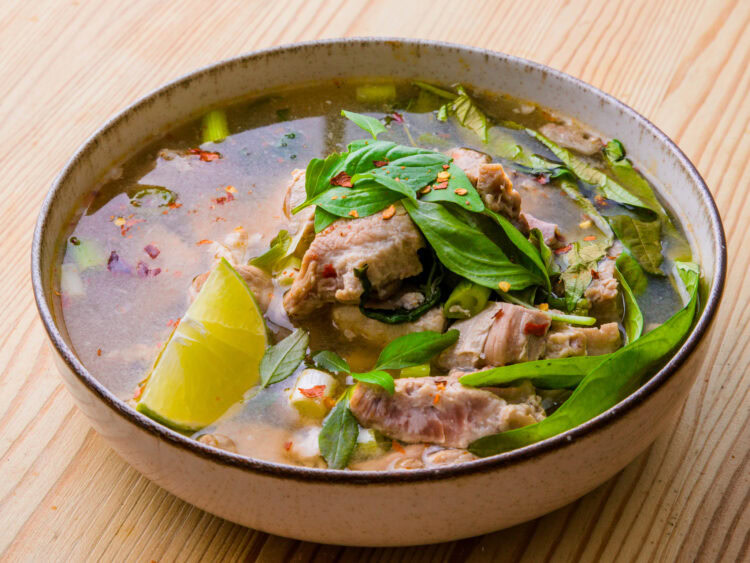A fragrant, spicy Thai Tom Saap soup where a simmered pork broth meets roasted herb paste, fresh lime, and chili flakes.
Say saap in the Isan dialect and the scene is set : the word simply means “delicious.” Add the simple verb tom (“to boil”), and you get Tom Saap—a bowl so aromatic it’s an edible shorthand for northeastern Thailand.
Tom Yum has made it onto postcards and restaurant menus abroad. The less-publicized Tom Saap keeps a resolutely northeastern accent, though it has now conquered Bangkok and many foreign capitals.
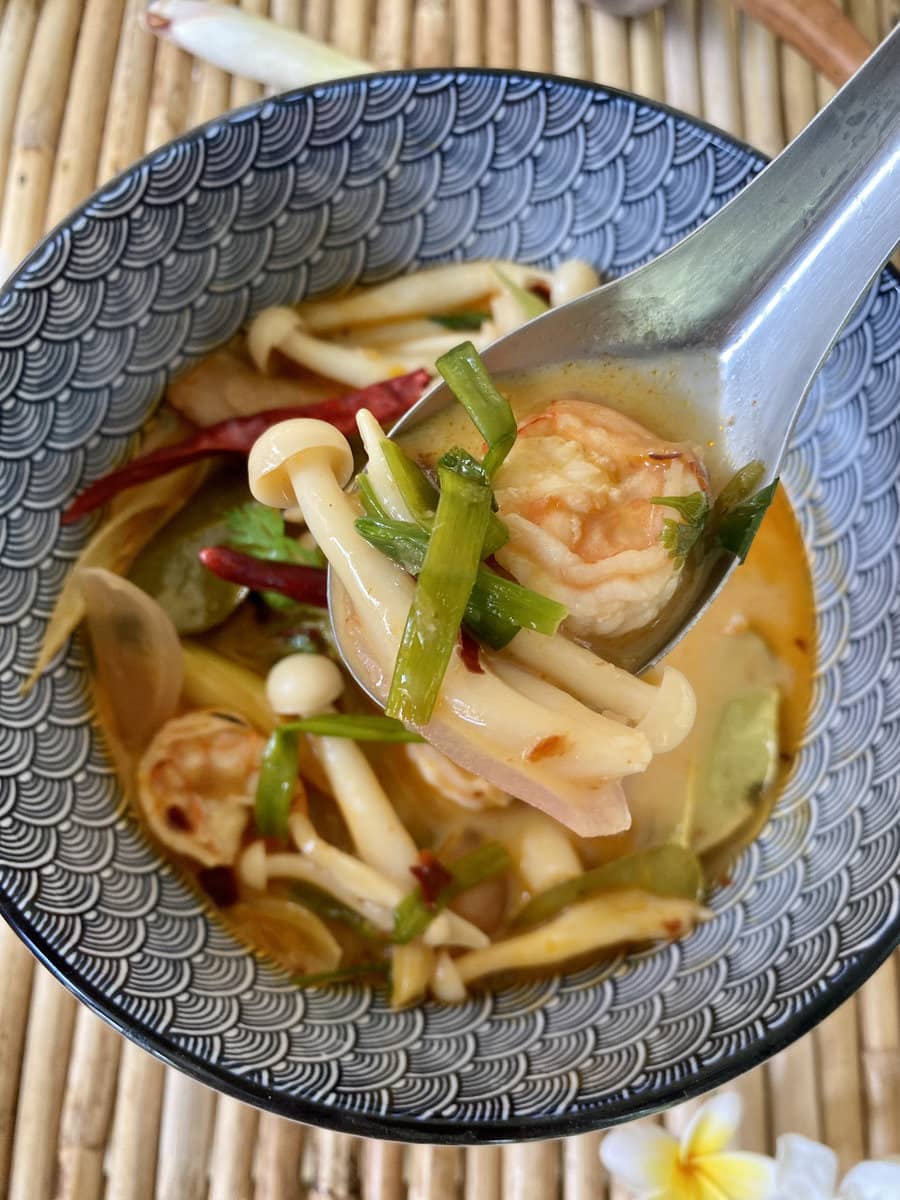
It’s a clear, bright broth, threaded with lemongrass, galangal, kaffir lime leaves, roasted chilies, and nutty roasted rice powder.
From rice-field fires to city streets : origins and cultural context
Tom Saap was born where rice paddies meet dense forest : a resourceful country soup that tenderizes tough cuts of beef, offal, or whatever fell into the pot.
The earliest broths simmered slowly over wood fires ; bones released their collagen while cow bile, prized for its clean bitterness, brought deeper complexity. Local cooks still cite the old saying : bo khom bo saap – บ่ขมบ่แซบ – “if it isn’t bitter, it isn’t delicious.”
By the late 20th century, waves of Isan laborers took third-class trains to Bangkok’s construction sites, carrying their cravings in tiffins. Street vendors followed, swapping beef offal for the more popular pork ribs while preserving the herb-driven aromatics.
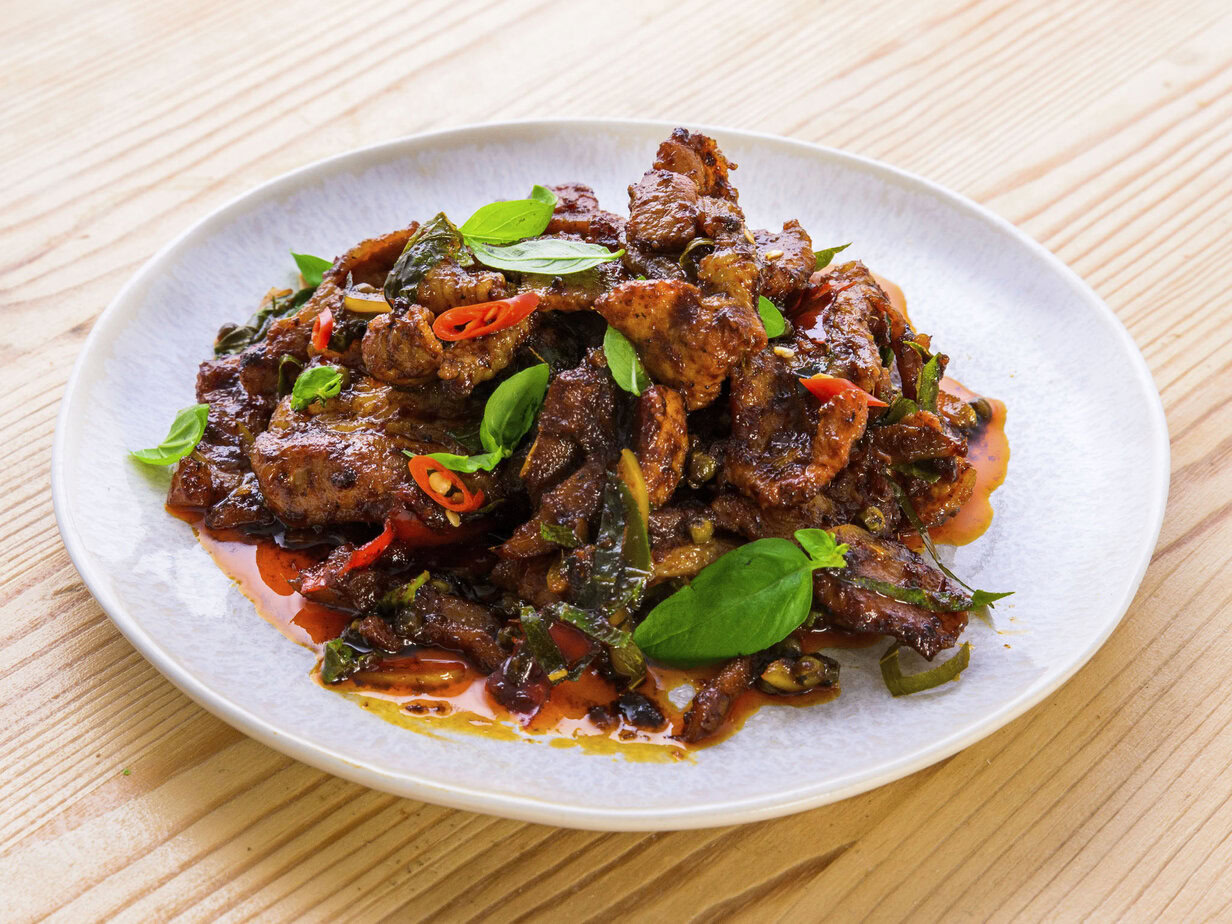
Night after night, bowls of Tom Saap fogged up plastic tables set outside beer towers, anointing the dish as the ultimate gap glaem (drinking snack) : food meant to keep baskets of sticky rice and gossip moving in equal measure. Today, you need only scan urban menus, from Singapore to Stockholm, to trace those migration paths : each bowl still speaks fluent Isan, even if the accent softens abroad.
What exactly is the real Tom Saap?
A true Tom Saap releases lemongrass first, then the clean, resinous note of galangal, before the citrus snap of kaffir lime leaves. If any is missing, the chord collapses.

Depth comes from a bone broth (pork ribs or beef shank) veiled by collagen, never by coconut milk. Once the heat is off, a handful of culantro (ผักชีฝรั่ง) and thinly sliced scallion (ต้นหอม) float on top ; “regular” coriander here is only a visitor from the Central region.
Chili comes in at two key moments : smoky flakes of roasted chilies stirred in from the start, then crushed bird’s eye chilies just before serving. Finally, the region’s signature—a spoonful of toasted rice powder—adds a campfire aroma and a faintly sandy texture that clings to the lips.
Balancing fire and tang, with a hint of bitterness
A proper bowl beads sweat on your temples while lime pinches the back of your jaw. Tamarind pulp simmers with the bones, offering a rounded, almost fruity acidity capable of supporting the heat.
Fish sauce provides salinity ; a dash of glutamate or fermented pla ra boosts umami, and sugar stays discreet, if it shows up at all. Beef versions still sometimes flirt with inherited bitterness (cow bile or an herbal porridge called khee pia), but those are footnotes, not obligations.
An opaque broth or heat offered as an option signals a knockoff : marked sweetness, coconut cream, or industrial tom yum paste means you’re no longer dealing with Tom Saap.
The different regional styles of Tom Saap
The original version, Tom Saap Neua, keeps its beef bones, a pinch of tripe, and a crown of mint leaves that softens the gamey note. Bangkok’s darling, Tom Saap Kraduk Moo, goes for pork ribs so tender they fall off at the first bite.

Order a Leng Saap and the kitchen will pile a tower of pork spine drowned in the same broth, chilies clinging to the vertebrae like confetti after a parade. Home cooks stretch the formula : chicken wings in Melbourne, dill-scented catfish in Khon Kaen, even 100% mushroom versions for vegetarian guests.
Every variation, however, preserves the two pillars of clarity and punch. On forums, debates pit monosodium glutamate (MSG) against a twelve-hour bone broth, argue over culantro availability in Minnesota, or the effectiveness of stand-in galangal powder (consensus : barely). Everyone still agrees on the essentials : clear broth, toasted rice, acidity that makes you nod “saap” without thinking.
Serving a bowl of this puts the regional credo “share the saap,” แชร์ความแซ่บ, into practice, passing flavors and camaraderie around the table. Rustic yet refined, the dish layers citrus and smoke, sweat and comfort, country lanes and city neon.
Whether it rises from a night-market cauldron in Khon Kaen or from your own pot, the lemongrass–lime steam invites you to dip the spoon back in, then breathe out the word แซบ อีหลี – “truly delicious.”

Ingredients
- 500 g pork cartilage pieces rib tips, or small pieces of spare ribs with cartilage and small bones
- 3 liters water
- 1 tablespoon mature galangal finely chopped, toasted
- 2 tablespoons lemongrass finely sliced, toasted
- 4 shallots thinly sliced, toasted
- 2 leaves makrut lime leaves finely sliced, toasted
- 3 roots cilantro roots chopped; substitute stalks (leaves removed) if needed; toasted
- 2 cloves pickled garlic lightly crushed; optional
- 1 teaspoon rock sugar
- 2 teaspoons salt
- 6 tablespoons fish sauce
- 4 tablespoons chicken breast minced (ground; not thinly sliced)
- 4 tablespoons lime juice freshly squeezed
- 1 tablespoon chili flakes toasted
- 2 tablespoons toasted rice powder homemade or store-bought at an Asian supermarket
- 1 handful green onions thinly sliced
- 1 handful culantro thinly sliced
- 1 handful Thai basil leaves
- basil tips extra for garnish
Instructions
- Bring the water to a rolling boil. Add the pork cartilage, then reduce to a gentle simmer and cook for about 1 hour, until tender.500 g pork cartilage pieces, 3 liters water
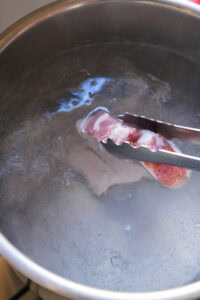
- Meanwhile, dry-toast the galangal, lemongrass, shallots, makrut lime leaves, and cilantro roots in a pan over low heat until aromatic, then pound into a fine paste.1 tablespoon mature galangal, 2 tablespoons lemongrass, 4 shallots, 2 leaves makrut lime leaves, 3 roots cilantro roots
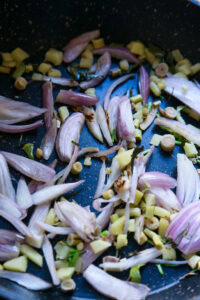
- Transfer half of the broth and cartilage to a small pot. Stir in half of the paste, one crushed garlic clove, rock sugar, salt, and fish sauce.2 cloves pickled garlic, 1 teaspoon rock sugar, 2 teaspoons salt, 6 tablespoons fish sauce
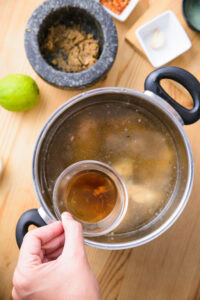
- Ladle some hot broth into a bowl with the minced chicken breast. Mash with a spoon to disperse evenly, then return the mixture to the pot.4 tablespoons chicken breast

- Season with the lime juice, toasted chili flakes, and toasted rice powder. Add the green onions, culantro, and basil leaves, then turn off the heat.4 tablespoons lime juice, 1 tablespoon chili flakes, 2 tablespoons toasted rice powder, 1 handful green onions, 1 handful culantro, 1 handful Thai basil leaves
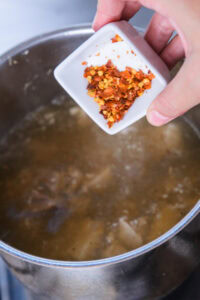
- Ladle the soup into a serving bowl, garnish with young basil tips, and serve piping hot.basil tips
Notes
- Minced chicken clouds the broth, giving it the slightly creamy look (น้ำข้น) prized in Isan restaurants.
- This recipe makes a double batch of the herb-and-seasoning paste; save the remainder for a second pot of soup.
- Keep the heat low after adding the lime juice; boiling will mute the fresh citrus aroma.
